Prior to building our smokehouse last year, Jesse used a home-made barrel smoker and an electric smoker to do all of his food smoking. These styles of smokers limited him to hot-smoking, which is a process that actually cooks the meat slowly while smoking it by keeping temperatures above 150 degrees F.
Cold-Smoking
Cold-smoking is an entirely different process that involves keeping the temperature during the smoking process somewhere below 70 degrees F. The primary reason we built our smokehouse was to be able to cold-smoke the traditional German sausage that Jesse’s family has been making for years. The large size of the smokehouse is because Jesse wanted to have the capacity to smoke 400-500 lbs of the sausage in a single batch instead of staying up nights tending the firebox. A nice side benefit is that he is also able to cold-smoke fish, cheese, ribs, chickens, turkeys, etc… which turns out a completely different product from hot-smoking.
The key design criteria for cold-smoking is to locate the firebox away from the smoking chamber to allow the smoke to cool before entering the smoke chamber. In Jesse’s design he has located the firebox 8 feet away and slightly down the hill from the smokehouse. The firebox and flue are built into the hillside, which allows the heat to be pulled out by the cooler soil temperature. It is also important to make sure that the flue pipe is at a slight incline to encourage proper drafting of the smoke from the firebox into the smokehouse and out the roof venting. Adequate venting is important to make sure that moisture does not build up in the smokehouse.
Making Cold-Smoked Salmon
Jesse cold-smoked some salmon last weekend. It was his second attempt and the texture and flavor turned out much better this time. The first attempt was with refrigerated salmon with no skin attached. The second attempt was with frozen wild salmon provided by a co-worker. We have found some information that frozen salmon is actually preferred for cold-smoking because it enables the curing process.
Before cold-smoking, the salmon needs to be thawed and cured. Curing preserves meat or fish with salt. There are endless variations of curing recipes, but the dry cure recipe that Jesse used this time was from Charcuterie; The Craft of Salting, Smoking and Curing. This book provides a wealth of information on these topics and has been an invaluable learning resource.
The dry cure recipe called for the following ingredients:
- 1/2 cup kosher salt
- 1/4 cup dark brown sugar
- 1/4 cup sugar
- 1 tsp. pink salt
- 1 tsp. ground white pepper
- 1 tsp. ground allspice
- 1/2 tsp. ground cloves
- 1/2 tsp. ground mace
- 1 1/2 T. dark rum
- 1 1/2 lbs. salmon fillet in one piece (skin on is preferable)
After mixing all the dry cure ingredients together, spread half of the mixture out in a dish or pan. It is helpful to choose a dish that is around the same size as the salmon fillets because the curing process extracts liquids out of the fish. Having a dish around the same size allows these liquids to remain in contact with the fish and becomes a natural brine for curing.
Time to sprinkle on the dark rum and add the rest of the dry cure mixture over the top. Make sure to sample the rum during this part of the process to make sure it is of good quality.
Once the salmon is covered with the remaining dry cure, cover it with plastic wrap. Sample the rum again, just to be sure.
Place a pan (or pans) on top of the salmon and put some type of weight in it to help extract the moisture. We used cans and a dressing bottle in between for weight.
Now it is time to put it in the refrigerator and let the curing process begin! It wouldn’t hurt to sample the rum again for good measure.
Jesse let the salmon cure for about 36 hours. You can tell when the curing process is complete because the salmon will become firm.
Once it is finished curing, it needs to be rinsed thoroughly under cold water to remove the excess salt.
After patting it dry with paper towels, we placed it on a rack out on the screen porch to dry. Drying is also an important part of the process because it allows the food to form a pellicle. The pellicle refers to the tacky surface that develops when food is dried and to which the smoke sticks, thereby adding the desired flavor. We dried the salmon for about 6 hours, but it could dry cure for up to 12 hours if needed for pellicle formation.
It’s finally show time! Time to fire up that smokehouse. Jesse used maple wood to smoke the salmon. His first attempt was with oak wood because he forgot he had a whole tree worth of maple sitting behind the garden. The maple wood had a much mellower flavor that we enjoyed.
I could not resist poking fun at these two little salmon fillets taking center stage in this ridiculously large smokehouse, but Jesse reminded me that the operating costs were still zero since the wood was stacked head high from a downed tree in the woods.
We thought the salmon was too smokey last time after being smoked about 6 hours, so this time he only smoked it for about 4 hours. Just about the right amount of smoke for our tastes.
After all the work that went into building the smokehouse, it is fun to see it get some use (even if it only for two measly slabs of salmon).
The finished product! I think it is best on a cracker with a thin layer of cream cheese. The smokey flavor was perfect; not too overpowering. Jesse will fine tune this recipe with some fruit woods in the future, and he has promised to also work harder to remove ALL the pin bones next time!

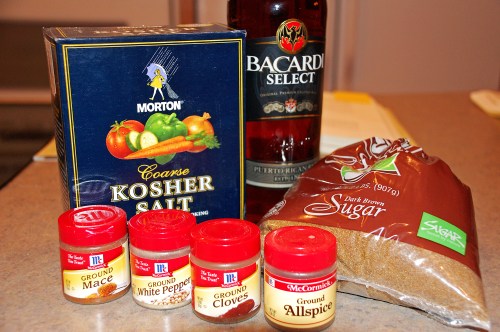
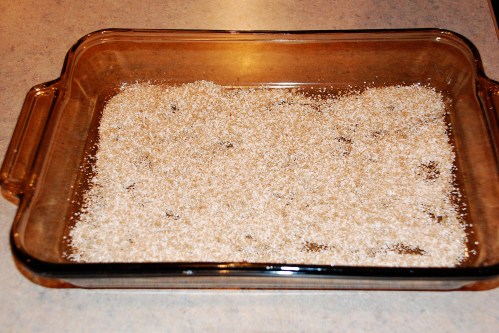

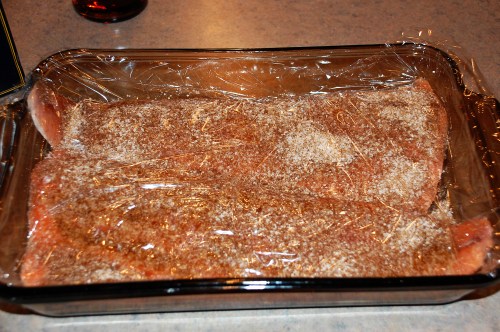





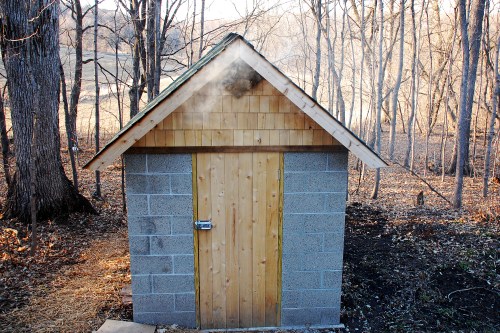



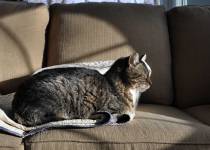

Looks delicious! But two pieces of fish are small, just to smoke them in a large smokehouse. Why do not you invite neighbors to enjoy your smoking shed for a small fee? Such featuring smokehouse should not stand idle. I think so.
PS Thanks for the recipe.
Really enjoyed reading about your cold smoking adventures! I had my first experiment with home-cured cold-smoked salmon last weekend, though my process was a bit more stripped down than yours – I blogged about it too, if you’re interested http://countryskillsblog.wordpress.com/2011/11/06/first-attempt-smoked-salmon/
Hallo,
Ziet er goed uit. Mooi verhaal zonder onzin en mooie foto`s. Ik heb dit gekopieerd. Ga jullie methode ook proberen.
Groeten,
Wil Wycisk- Rotterdam.